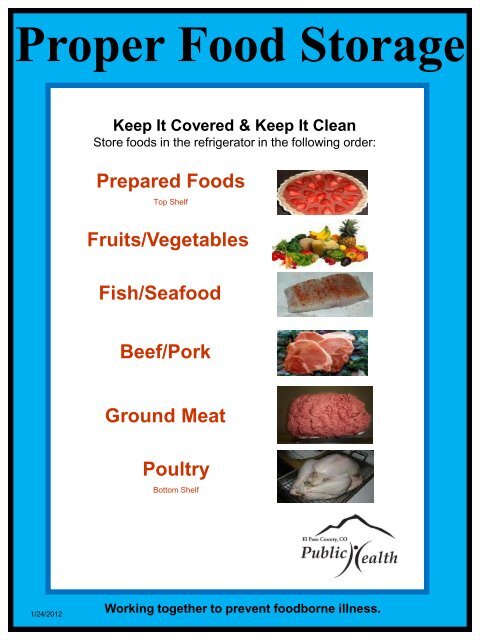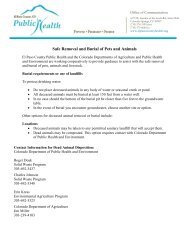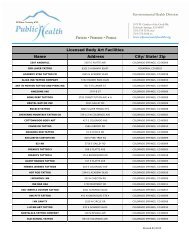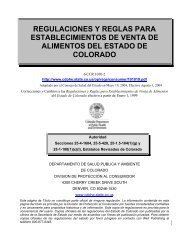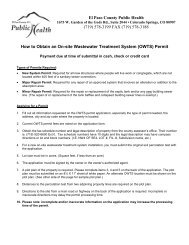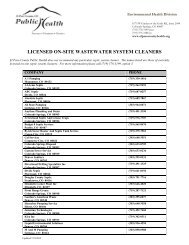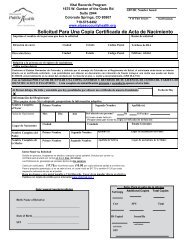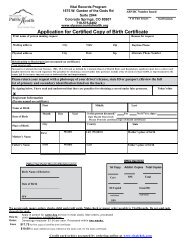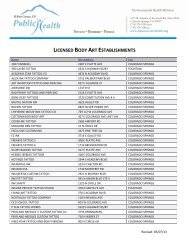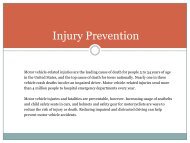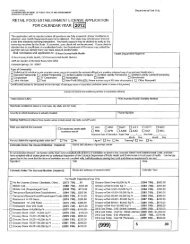Food Safety Flyers - El Paso County Public Health
Food Safety Flyers - El Paso County Public Health
Food Safety Flyers - El Paso County Public Health
Create successful ePaper yourself
Turn your PDF publications into a flip-book with our unique Google optimized e-Paper software.
Separate Cooked and Raw <strong>Food</strong>sKeep It Covered & Keep It CleanStore foods in the refrigerator in the following order:Prepared <strong>Food</strong>sTop ShelfFruits/VegetablesFish/SeafoodBeef/PorkGround MeatPoultryBottom Shelf1/24/2012Working together to prevent foodborne illness.
Hold at specified temperaturefor 15 seconds to kill bacteriaPoultry 165°F• Includes chicken, turkey, duck andgoose• Soups, stews, stuffing, casseroles• Stuffed meat: poultry, fish and pasta• Leftovers (to reheat)Ground Meats 155°F• Includes hamburger, sausage, meatloafand other ground meats and groundfish• Eggs – cooked and held for service(such as scrambled)Whole Meats & Fish145°F• Beef, lamb, veal, pork, ham (steaks,chops and roasts)• Fish, shellfish• EggsWash and sanitize your thermometer aftereach use.1/24/2012Working together to prevent foodborne illness.
Safe ThawingIn a refrigeratorUnder coldrunning waterAs a part of cookingIn a microwaveDo not allow any portion of thefood to be above 41°F for morethan 4 hours!1/24/2012Working together to prevent foodborne illness.
Handwashing MethodsUse soap and warm running water.Rub your hands vigorously for 20 seconds.Wash all surfaces, including:•Backs of hands•Wrists•Between fingers•Under fingernailsRinse well.Dry hands with a paper towel.Turn off the water using a paper towelinstead of bare hands.1/24/2012Working together to prevent foodborne illness.
Rapid Cooling Means Safe <strong>Food</strong>•The quicker food products cool, the safer they are. Bacteria grows rapidly inthe temperature range danger zone, from 41ºF - 135ºF.•If you fail to meet any of the time/temperature parameters the foodmust be thrown away. During the first cooling stage (135-70°F) if you knowyour product will not cool in 2 hours, but it hasn’t passed the 2 hour time limit,you may reheat it to 165°F once and attempt the cooling process again.2HOURS4HOURSProper Cooling135˚F57˚C70˚F21˚C41˚F5˚CFactors Which Speed theCooling of <strong>Food</strong>s:CONTAINERS: Aluminum and stainless steelmetals chill food the fastest.Glass and plastic are insulators,so the food cools more slowly.VOLUME:STIRRING:Reduce large quantities of heatedfood to smaller amounts. Smallbatches in shallow metal pans chillthe fastest.Speed up cooling by stirring thefoods. Stir the foods every 15minutes or each time you walk by.AIRCIRCULATION: To cool foods faster, chill partiallyuncovered, then cover once food iscold. Stacked pans block air circulation.When stacked, the pile of pansacts as a hot unit. Maximize air flowin the cooler by using commercialwire racks and by not blockingthe fans.Large quantities of hot foods must be cooled using one of these methods:1. Metal containers not more than 3 inches deep2. Using a frozen ice paddle or ice wand3. Using an ice bath, stirring often (the level of ice must be the same depth outside asthe product is inside to be most effective)Note: The use of a cooling log is recommended.1/24/2012Working together to prevent foodborne illness.
Calibrating a Bi-MetallicStemmed ThermometerWhen:How:•At least once a week•After a thermometer is dropped or after rough handling•After extreme temperature changes•Fill a medium sized glass with half ice and half water. Placethe thermometer in the ice water.•Wait 3 minutes, stirring water occasionally.•After 3 minutes, thermometer should read 32°F.Corrective Action:If thermometer does not read 32°F:1. Leave it in the ice water.2. Using pliers or an adjustablewrench, turn adjustable nut (ifavailable) on the back ofthermometer until needle reads32°F (it may be necessary to addmore ice). For digital thermometerssee manufacturers instructions.3. Wait 3 minutes, stirringoccasionally.4. After 3 minutes, thermometershould read 32°F (if not, repeatcorrective action).Hex Adjusting NutHeadStemIce Water(32°F, 0°C)2” (5cm)Minimum1/24/2012Working together to prevent foodborne illness.
Chemical SanitizerConcentrationsWhen used for dishwashing, sanitizingstationary equipment, and wiping cloths:•Chlorine (bleach) – 50 to 200 ppm*•Iodine – 12.5 to 25 ppm•Quaternary Ammonia – use according to manufacturer’sinstructionsHow often should I sanitize?•For items in continual use (i.e., hot dog tongs) sanitizeevery 4 hours.•For items not in continual use, sanitize when theybecome soiled.*ppm = parts per millionMake sure that the proper test strips are available.Make sure the instructions for test strips are followed(test strips have different “dip” times).1/24/2012Working together to prevent foodborne illness.
Dishwashing By HandHot Water & DetergentAgua Caliente y DetergenteClean WaterAqua ClaraWater and SanitizerAqua y DesinfectanteScrapeLimpiarWashLavarRinseEnjuajarSanitizeDesinfectarAir DrySecar al AireChange your water frequently. Cambie el aqua con frecuencia.WASHWith detergent in water at no less than 110°F.RINSEIn clean hot water.SANITIZEWith an approved sanitizer such as chlorine (bleach),quaternary ammonia or iodine for at least one minute.1/24/2012Working together to prevent foodborne illness.
1/24/2012Storage Room Basics Maintain temperaturebetween 50°F and 70°F. Use FIFO Storage: FirstIn, First Out. Store items at least sixinches above floorsurface. Store chemical itemsseparately from food. Keep floors clean. Keep area free fromclutter.6 inchesWorking together to prevent foodborne illness.
Produce/Salad AreaClean and sanitize slicers,choppers, and otherequipment before and aftereach use.Use separate cuttingboards for raw meatsand vegetables.Use clean andsanitized utensils foreach different task.Clean and sanitizework surfaces beforeand after each use.Wash produce inprep sink only.1/24/2012Working together to prevent foodborne illness.
Personal Cleanliness andHygienic PracticesYou are the most importantpart of food safetyMaintain a high degree of personal cleanliness andgood hygienic practices.Remove jewelry before reporting to work.Wear a clean uniform that is free from stains andwrinkles.Keep fingernails clean, trim, filed, and maintained.Polished or artificial nails are not permitted whenworking with exposed food, unless gloves are worn.Consume food and drinks in designated areas only.No employee, while infected with a communicabledisease that can be transmitted by food, shall work in aretail food establishment.All wounds shall be covered by waterproof bandagesand single-use gloves if on the hands or wrist.Working together to prevent foodborne illness.1/24/2012
Proper Holding TemperaturesKeephot foodsabove135˚F135˚F57˚CKeep foods out ofthis temperaturerange:135˚F – 41˚FThrow out food if it is inthe DANGER ZONE forlonger than 4 hours.Keepcold foodsbelow41˚F41˚F5˚C1/24/2012Working together to prevent foodborne illness.
Separate!Don’t Cross-ContaminateUse a separate cutting board for produce and rawmeat.Never place cooked food back onto a plate thatpreviously held raw meat, poultry, seafood, oreggs.Wash your hands in between tasks.Sanitize all surfaces between tasks.Cook all foods to the appropriate temperature.1/24/2012Working together to prevent foodborne illness.


